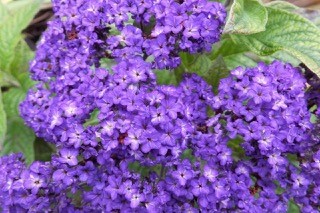
If your greenhouse will overwinter Pelargoniums then it’s perfect for Heliotropes, members of the Borage family, mostly introduced from S. America in the 18C. The European Heliotrope was thought by the Ancients to turn its flowers to catch the sun thus the name. However the massed flowers of H. arborescens, Cherry Pie do not move, or not perceptibly. Which does not matter as although sumptuous these blooms are for our nose as much as our eye. Heliotrope has greenhouse filling, wonderfully rich fruity perfume, remarkably pleasing, though to be honest not resembling cherry pie, more like almond.
Heliotrope has near a hundred species, white, lilac or blue bloomed, however few other species have any perfume whereas H. arborescens, white and blue, are powerfully scented. I say blue I mean deepest marine, indeed some are so named: Marine, Marino, Princess Marina, though also White Lady and White Queen.
Cherry pie grows into a shoulder height shrub in warmer countries but stays more compact when container grown under cover. It needs sun and warmth but does not like parching hot positions, happier lower down or in dappled shade then the already long blooming flower heads can continue longer. Although perennial, as with Pelargoniums, plants can be pruned and reused but are better regularly replaced from cuttings and discarded once scrappy. But if you want a true cultivar then cuttings are the way to preserve and multiply.

However for vigorous plants you can’t beat from seed. Treated much like any other tender or half tender annual your plants will flower summer into autumn from an early spring sowing in your propagator. Potted up individually the final size of plant will depend on the size of container; they cope with small pots, and give stunning performances in larger ones.
Preferring loamy gritty compost these don’t like waterlogging, nor getting their leaves splashing, otherwise trouble free just needing regular watering and light feeding. Cuttings can be taken at any time and as noted it’s often better to overwinter late summer cuttings and discard older plants.
A connoisseur could build up an interesting collection of these once highly fashionable plants as though long out of favour just recently several old varieties have been recovered, you can now buy twenty or more. It’s more difficult to collect the hundred or so species, anyway mostly unscented these are less appealing.


